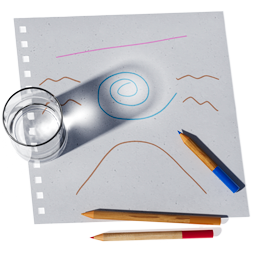My last ceramic sculpture was competed c1977. The last analog painting was finished in the mid 1980s. It follows that my first serious digital drawings and paintings came along about the same time. In 2004 I collaborated on a recycled-glass-pieces-mosaic-over-concrete public art sculpture. But, other than that, for nearly 40 years I've been creating using digital tools. Starting in the mid-late 80s, using the first versions of both, it was Illustrator and Photoshop. I continue to use them daily but they are no longer my primary tools.
These days most all of my works are images of models that are created/sculpted, textured, arranged, and rendered, using a combination of 2 and 3D software. I print selected images, in 2D, on canvas or panels, when the need arises. As with the majority of my previous digital works, photographic elements are rarely directly used in the creation of these images. Neither do I use generative AI tools nor objects or images created by others. My works are certainly not “computer generated” any more than another artist’s oil paintings were generated by a paint-filled camel-hair brush. As the artist, I use tools. Those tools are simply digital, rather than analog.
I do shoot a lot of photographs—3,000 per year on average. At least half of the images in the home page slide shows are photographs. A lot of the photos shot are for, or of, projects I'm working on with my wife, Tanya. Some are shots of our travels. A lot are birds and plants in our yard. Most are for inspiration, documentation. or reference. In the late 80s and early 90s I contributed to the creation of the tiling photo-based texture collections which were marketed as Wraptures to the early 3D texturing world. These days none of my photographs are used in the creation of the textures for the objects in my images. The textures for my 3D work are procedurally/mathematically derived, “painted” from scratch in Illustrator and/or Photoshop, or created using a combination of the two. The finished textures are then mapped to the surfaces of the objects using a couple of different 3D programs.
At one time, calling my creations digital drawings and paintings seemed completely appropriate, as they were created using software with their digital pens and brushes. As my work strays further away from using those digital painting tools, I’m feeling less comfortable calling them digital paintings. Our friend Zig is an artist who uses analog tools exclusively—real pencils and brushed paint onto board or canvas. Using these tools he creates beautiful drawings and paintings. Unequivocally—they are drawings and paintings. The same can not be said about my work for the simple reason that I am not using a brush and paint. Zig feels it is inaccurate to call my works paintings—a perspective which totally makes sense. But for better or worse, I find myself hanging on to the term, and using it in casual references to my work, because I haven't found a better one. And, since my intent is for my digital works to share some of the painterly qualities of my previous analog work, it is somewhat easier to explain, if anyone is interested, how I fulfill the design intent using digital tools.
Regardless of what label is used to categorize my work, a big circle has been made. From sculpture back to sculpture. Pixels now instead of clay. No longer are copious quantities of fossil fuel being used to fire the ceramic pieces. While I miss the kinesthetics of working clay, I’m elated to no longer be using the toxic chemicals and heavy metals in the lusters, glazes, and paints or breathing silicosis-inducing clay dust. I am happy to no longer find myself needing to wear a respirator, working in a spray booth while using an airbrush, to keep from breathing atomized liquid plastics and pigments. And rather than fossil fuels, it is the array of photo-voltaic panels on the roof that power the small farm of computers in my studio.
Lastly, and while it seems I have your attention… Art should be about a feeling conveyed or an insight shared. A smile. A tear. Conflict. Harmony. ¿Perhaps a quandary? When the first thought of a viewer is to discount an image based on the medium, there may be a bit of trouble between someone’s ears that needs addressing. This is not to say that having a strong preference is unacceptable. Personal favorites, such as preferring oils on canvas or conte crayon (but only if it is on hand-made rag paper) are absolutely fine. Neither am I saying anyone is wrong if they do not like my art. Individual tastes are foundational to a vibrant and diverse world. Being curious and asking questions about the techniques and/or the medium can be educational—potentially valuable for all parties. But summarily dismissing a work simply for the choice of technology the artist made, without evaluating content and intent, strikes me as being an act of ignorance. If we choose to live with such a closed mind, we risk missing out on the joy of discovery and the possibility of an enlightening experience.
Please enjoy responsibly!
Thanks and cheers,
gsb
